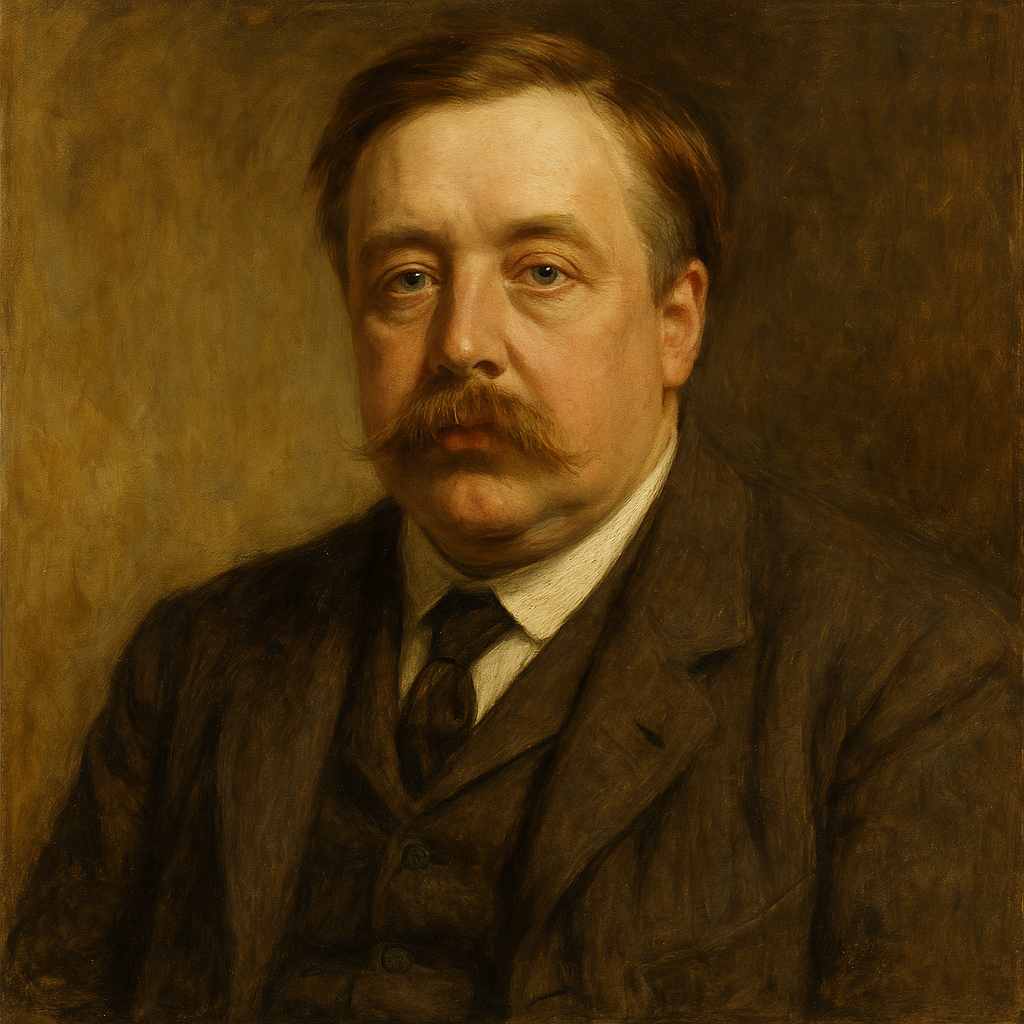There Shall be More Joy
Ford Madox Hueffer
1873 to 1939

The little angels of Heaven
Each wear a long white dress,
And in the tall arcadings
Play ball and play at chess;
With never a soil on their garments,
Not a sigh the whole day long,
Not a bitter note in their pleasure,
Not a bitter note in their song.
But they shall know keener pleasure,
And they shall know joy more rare—
Keener, keener pleasure
When you, my dear, come there.
The little angels of Heaven
Each wear a long white gown,
And they lean over the ramparts
Waiting and looking down.
Ford Madox Hueffer's There Shall be More Joy
Introduction
Ford Madox Hueffer's poem "There Shall be More Joy..." presents a deceptively simple tableau of celestial bliss, only to subvert it with a poignant twist that speaks to the complex interplay between earthly and divine love. This analysis will delve into the poem's structure, imagery, and thematic elements to uncover the layers of meaning embedded within its seemingly straightforward verses. By examining Hueffer's craftsmanship and the cultural context in which the poem was written, we can gain insight into the work's exploration of innocence, experience, and the transformative power of human affection.
Structure and Form
The poem consists of four quatrains, each following an ABCB rhyme scheme. This regular structure, reminiscent of ballads and hymns, lends the poem a musical quality that enhances its ethereal subject matter. The consistent meter, primarily iambic tetrameter with occasional variations, creates a rhythmic cadence that mimics the gentle, playful activities of the angels described in the opening stanzas.
Hueffer's choice of form is significant, as it establishes a sense of order and predictability that mirrors the idyllic heavenly realm he initially depicts. However, this very regularity serves to heighten the impact of the poem's unexpected turn in the third stanza, where the introduction of a new element—the anticipated arrival of the speaker's beloved—disrupts the established pattern both thematically and rhythmically.
Imagery and Symbolism
The poem's imagery is rich with traditional Christian iconography, presenting a vision of heaven that aligns with popular conceptions of the afterlife. The "little angels" in their "long white dress[es]" evoke purity and innocence, while their activities of playing ball and chess suggest a harmonious and carefree existence. The "tall arcadings" create a sense of grand, ecclesiastical architecture, further reinforcing the celestial setting.
However, Hueffer's portrayal goes beyond mere description, employing symbolism to convey deeper meanings. The angels' white garments, "never a soil" upon them, symbolize not only purity but also a lack of worldly experience. The absence of sighs and "bitter note[s]" in their pleasure and song underscores this innocence, yet also hints at a certain limitation in their emotional range.
The imagery shifts subtly in the latter half of the poem. The repetition of "Keener, keener pleasure" emphasizes the intensity of the anticipated joy, while the angels leaning "over the ramparts" creates a visual metaphor for the boundary between heaven and earth. This image of anticipation and yearning introduces a new dimension to the heavenly realm, suggesting that even paradise may be incomplete without the depth of human love and experience.
Thematic Analysis
At its core, "There Shall be More Joy..." explores the tension between divine perfection and human love. The poem's title, alluding to the biblical passage about joy in heaven over one sinner who repents (Luke 15:7), sets the stage for a reinterpretation of celestial happiness. Hueffer subverts the traditional hierarchy that places divine love above earthly affection, suggesting instead that human love can enhance and even surpass the joys of heaven.
The first two stanzas establish a picture of heavenly contentment that, while idyllic, is characterized by a certain stasis. The repetition of "Not a... Not a..." emphasizes the absence of negative experiences, but also implies a lack of growth or change. This unchanging state is contrasted sharply with the "keener pleasure" and "joy more rare" promised by the arrival of the speaker's beloved.
This juxtaposition raises profound questions about the nature of joy and fulfillment. Hueffer seems to argue that true happiness requires the context of sorrow, that pleasure is heightened by the experience of pain. The human beloved, having known the vicissitudes of earthly existence, brings a depth of feeling that the angels, in their perpetual innocence, cannot match.
Moreover, the poem touches on the concept of individuality and personal connection. The angels, described collectively and engaged in timeless activities, lack the specific, intense bond that the speaker shares with their "dear." This suggests that the particularity of human relationships, forged through shared experiences and individual choices, possesses a unique value that transcends even heavenly bliss.
Cultural and Literary Context
To fully appreciate Hueffer's poem, it is essential to consider its place within the broader literary and cultural landscape of its time. As a contemporary of modernist poets like Ezra Pound and T.S. Eliot, Hueffer (who later changed his name to Ford Madox Ford) was part of a movement that sought to challenge traditional forms and themes in poetry.
While "There Shall be More Joy..." maintains a conventional structure, its content subtly subverts expectations. The poem's elevation of human love over divine perfection can be seen as a modernist rejection of established religious hierarchies. Furthermore, the emphasis on individual experience and the transformative power of personal relationships aligns with the modernist focus on subjectivity and the inner life of the mind.
The poem also reflects the changing attitudes towards love and spirituality in the early 20th century. As traditional religious beliefs were increasingly questioned, many turned to human relationships as a source of meaning and transcendence. Hueffer's work captures this shift, presenting a vision of heaven that is ultimately enriched and completed by earthly love.
Stylistic Devices and Poetic Technique
Hueffer employs several poetic devices to enhance the emotional impact and thematic depth of the poem. Repetition is used effectively throughout, from the echoing of phrases like "long white dress" and "keener pleasure" to the parallel structure of the first and fourth stanzas. This repetition creates a sense of cyclical time that reinforces the eternal nature of the heavenly realm while also emphasizing the anticipated change.
The poet's use of alliteration, particularly in phrases like "bitter note" and "keener, keener," adds a musical quality to the verses that complements their rhythmic structure. This musicality not only enhances the poem's aesthetic appeal but also serves to underscore the idea of heavenly harmony and its eventual transformation.
Hueffer's diction is carefully chosen to create a balance between the ethereal and the tangible. Words like "arcadings" and "ramparts" lend a concrete specificity to the heavenly setting, while the repeated use of "little" to describe the angels creates a sense of intimacy and approachability that contrasts with traditional depictions of awe-inspiring celestial beings.
Conclusion
"There Shall be More Joy..." is a masterful exploration of the intersection between divine and human love. Through its careful structure, evocative imagery, and nuanced thematic development, the poem challenges readers to reconsider their understanding of happiness, fulfillment, and the nature of heavenly bliss.
Hueffer's work stands as a testament to the power of poetry to address profound philosophical and spiritual questions within the confines of a seemingly simple lyric. By presenting a vision of heaven that is ultimately enhanced by human love, the poem offers a unique perspective on the relationship between the earthly and the divine, suggesting that true transcendence may lie not in escaping human experience, but in embracing its depths and complexities.
In the end, "There Shall be More Joy..." leaves us with a poignant reminder of the value of our earthly connections and experiences. It suggests that far from being impediments to spiritual fulfillment, our human relationships and the knowledge gained through living may be the very things that allow us to access the deepest and most profound forms of joy—a joy so potent that it can bring new vitality even to the realm of angels.
This text was generated by AI and is for reference only. Learn more
Want to join the discussion? Reopen or create a unique username to comment. No personal details required!



Comments
No comments yet. Be the first to comment!